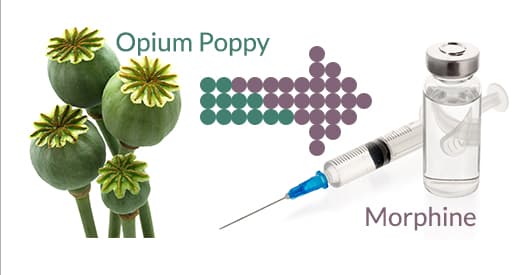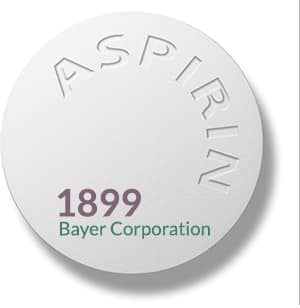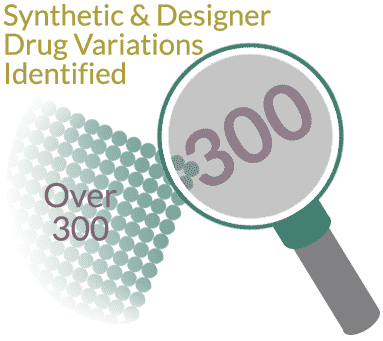The history of medicines and drugs dates back thousands of years, as plants, natural products, and herbal remedies were used for healing ailments.
Morphine, the first commercial drug – a derivative of the opium poppy plant used for pain relief and sedation – was introduced by Merck in 1826.[1]
Researchers and scientists began experimenting with synthetic compounds, and in 1869, chloral hydrate was introduced as the first synthetic, or man-made, drug. It was produced as a sedative-hypnotic and is still in use today.[2]

Aspirin was the first successful and popular medication that was manufactured as a blend between natural elements, salicylic acid from the white willow tree, and chemical modification to make it less bitter and easily digested.
Treatment Can Be Life Changing. Reach out today.
Whether you are struggling with addiction, mental health or both, our expert team is here to guide you every step of the way. Don’t wait— reach out today to take the first step toward taking control of your life.
Aspirin was released as an over-the-counter pain reliever, fever reducer, and anti-inflammatory medication in 1899 by the Bayer company.[3]This may have opened the door for chemists to begin modifying all types of products, and drug discovery and production exploded into the 21st century and beyond.

Abuse of Synthetic Drugs
Many herbal remedies and medications are used and abused for recreational purposes as well as for their healing or medicinal properties. Synthetic drugs, used recreationally, are generally plant material laced with chemicals to produce psychoactive, or mind-altering, effects, and they fall into two main categories: cathinones and cannabinoids. Cathinones are stimulants with effects similar to cocaine and methamphetamine, while cannabinoids are usually forms of synthetic marijuana.
These products may be hiding in plain sight, sold in gas stations, head or tobacco shops, over the Internet, or in convenience stores and marketed as “organic” or “natural.” They are smoked, snorted, mixed in drinks, and swallowed. Due to their relative newness on the market, many synthetic drugs will not show up on a drug test either, thus heightening their appeal.
Synthetic drugs have the following street names:
- Spice
- K2
- Bath salts
- Moon rocks
- Fake weed
- Skunk
- Yucatan Fire
- Scooby Snacks
- White Lightning
- Blaze
- Smiley
- No More Mr. Nice Guy
- Stardust
- Vanilla Sky
- Ivory Wave
- Blue Silk
- N-Bomb
- Red Dawn
- Genie
- Zohai

Another club drug, Molly, is also a man-made synthetic drug that contains MDMA, one of the active ingredients in ecstasy, as well as many other lab-created chemicals and dangerous toxins. Molly is generally not put into the class of drugs labeled synthetics; it is instead considered a hybrid between a stimulant and a hallucinogen.
- Synthetic drugs are mostly popular with adolescents as 11.3 percent of 12th graders abused synthetic marijuana in 2013.
- Among adolescents, synthetic drugs are the second most popular illicit drug behind only marijuana.[4]
- Over 300 different variations of synthetic and designer drugs have been identified in the past several years in the United States.[5]
- Many of the variations of these drugs are legal, and teens may view them as “safer” than other illicit drugs or substances.
- Poison control centers across the country received 3,680 calls about exposure to synthetic drugs in 2014.[6]
- Several deaths have also been reported, some from just one dose of a synthetic drug.[7]

Bath Salts
Synthetic cathinones are most commonly referred to as “bath salts” and sold in crystalline powder form. Bath salts are generally snorted or ingested, although sometimes users dissolve and inject them. The main ingredient in these synthetic drugs is generally either 4-methylmethcathinone, mephedrone, or 3,4-methylenedioxypyrovalerone (MDPV).[8] Both substances are psychoactive stimulants that can produce hallucinations, delusions, and altered perceptions while suppressing the appetite and need for sleep. The effects of these drugs may be similar to those of methamphetamine or ecstasy.
Mephedrone and MDPV act on the brain’s chemical messengers, or neurotransmitters, affecting the production and absorption of dopamine, serotonin, and norepinephrine. These neurotransmitters are responsible for feelings of pleasure, emotional regulation, and moods as well as energy and focus. Simply stated, these drugs can give a temporary rush that makes the user feel good and increases concentration and activity levels.
These drugs are highly dangerous, however. Since they are generally created in illegal and unregulated labs, a user may never be sure exactly what is in the dose he is taking. Both MDPV and mephedrone are listed as Schedule I drugs by the Drug Enforcement Agency, DEA, meaning that they have no accepted medicinal use in the United States, a high potential for abuse and dependency, and are considered generally unsafe.[9]
Side effects of bath salts may last up to eight hours and include:
- Paranoia
- Violent or aggressive behavior
- Vivid hallucinations
- Increased confidence and lowered inhibitions
- Self-mutilation
- Chest pain
- Nausea
- Inability to sleep
- Decreased appetite
- Seizures
- Psychosis
- Dependence and/or addiction
Some particular variations of bath salts were created to mimic the effects of the powerful hallucinogen LSD. These designer drugs, 2CI-NBOMe and 25C-NBOMEe were found to be alarmingly more potent, with only a few grains necessary to produce a high.[10] The more potent a drug is, the easier it is to accidentally take too much, increasing toxic levels that the body can’t break down and causing an overdose which can be life-threatening or lead to permanent brain damage.
Regular abuse of these substances can increase one’s tolerance to their effects, meaning the user will need to increase his dosage in order to feel them. This tolerance may rapidly develop into a physical and psychological dependence wherein the user may crave the drugs and feel out of balance without them, which is considered an addiction or substance abuse disorder. Chronic abuse of bath salts may also cause kidney and liver damage or failure, long-term mental illness, and an increased risk for suicidal behavior.
Spice or Synthetic Marijuana
Spice is often referred to as “fake weed” or synthetic marijuana since it works on the same regions of the brain as the natural version, and it is often manufactured by grinding up plant material sprayed with other chemicals. Both plant-based marijuana and synthetic marijuana are typically smoked and activate CB1 receptors with mind-altering effects, making users feel relaxed and pleasant. This is where the similarities end, however. Marijuana contains tetrahydrocannabinol, or THC, which is the active ingredient and considered a partial agonist. Synthetic marijuana is not natural or derived from plants; instead, it is formulated in a lab. It is considered a full agonist and manufactured to bind tightly to the cannabinoid, CB1, receptors, throughout the brain and body; therefore, Spice is considered 100 times more potent than THC.[11]
Spice is considered 100 times more potent than THC.
Full agonists are more effective than partial ones, and the body may have a harder time breaking them down. Synthetic marijuana also lacks cannabinol, which is one of the ingredients in plant-based marijuana that may dilute or block some of the more dangerous side effects.[12] Teens wanting a “high” may take synthetic marijuana products and get more than they bargained for. These drugs are widely unpredictable and affect each person differently. Younger users in particular may be more susceptible to the negative side effects of Spice, which can induce psychosis and other mental health problems.[13]
Also, since Spice is created in non-regulated and underground labs, the chemical compounds can vary greatly from batch to batch, which may create unintended toxic interactions. There is virtually no way for a casual user to know exactly how potent or precisely what chemicals are in each batch of Spice, increasing the chances for an accidental or unintentional overdose.
An overdose is also vastly different looking for a synthetic version of marijuana than the natural versions as well. While excessive marijuana generally makes users mellow, slow, and laidback, synthetics can have the opposite reactions, leaving abusers agitated, sweaty, and hostile. Synthetic marijuana can raise blood pressure, heart rate, and temperature to dangerous levels, sometimes resulting in myocardial ischemia, a reduction in blood flow to the heart, or a heart attack.[14]
Other potential dangerous side effects of abusing Spice include:
- Nausea and/or vomiting
- Anxiety
- Confusion
- Paranoia
- Hallucinations
- Difficulties with short-term memory
- Decreased motivation
- Mood swings
- Convulsions
- Stupor
- Headaches
- Seizures
- Stroke
- Brain damage
- Death
As with other synthetic drugs, Spice is potentially addictive, both emotionally and physically, and regular abuse may lead to brain damage as well as damage to internal organs. Mixing substances such as Spice or bath salts with alcohol or other drugs increases all the risk factors as well. If you or someone you know is struggling with synthetic drug abuse, spice addiction treatment is available. Contact The Recovery Village today for more information.
The Legal Battle of Synthetics
Many synthetic drugs are sold under the guise labeled “not intended for human consumption,” in order to avoid regulation by the federal Food and Drug Administration, even though they are manufactured and intended to be smoked, snorted, or swallowed for recreational purposes. These substances are sold as “jewelry cleaner,” “incense,” and other “herbal” mixtures, and in many cases, they are perfectly legal.
In December of 2008, the U.S. Customs and Border Protection (CBP) seized the first known shipment of Spice in Ohio.[15]Prior to 2010, there was no federal regulation at all for these hazardous chemicals, although the DEA and federal agencies are now racing to catch up.
The DEA convened an emergency scheduling authority in 2011 to place five cannabinoids and three cathinones into Schedule I of the Controlled Substances Act (CSA), making it illegal to possess, manufacture, or handle them.[16]Three more cannabinoids were added to this temporary designation in 2012, and later that year, the Synthetic Drug Abuse Prevention Act was signed into law, placing 26 known cathinones and cannabinoids permanently into the Schedule I designation.[17]
Unfortunately, as one substance is discovered and marked illegal, manufacturers create new chemical synthetic and potentially hazardous compounds. More synthetic substances continue to be added as temporary Schedule I substances as they are discovered.[18]Currently, at least 44 states have actions in place to control at least one cathinone, and at least 43 states have similar actions for controlling one or more cannabinoids.[19]A DEA spokesman, Rusty Payne, told NBC News that trying to keep up with synthetic drugs is “like playing whack-a-mole,” as one synthetic drug is controlled, another one pops up in its place.[20]
Keeping Kids Safe
One of the best methods to protect kids from current drug use trends is by maintaining open lines of communication with your kids and educating yourself on what is out there. Drugs and recreational abuse methods are constantly changing, and new synthetic drugs are coming to the surface daily. Education and prevention are considered the best course of treatment to date. Conversations started in a relaxed and informal setting may be a good way to initiate the discussion about the dangers of abusing, or even trying, synthetic drugs.
The Internet plays a large role in synthetic drug abuse as well. Teens are able to get on drug forums and discuss potential synthetics, their desired effects, and even order them online. Many of these drugs are being shipped to the United States from illicit laboratories in China and sent through regular mail services.[21]Monitoring what adolescents are doing online and watching for suspicious packages in the mail can help you remain vigilant about synthetic drug abuse. Furthermore, if you do suspect synthetic drug abuse or addiction, help is available, and you should contact a professional for assistance. Treatment may include detox, behavioral therapies, counseling, and support groups. Skilled professionals can even assist you in setting up a successful intervention if necessary.
While the recreational use of synthetic drugs and products to create mind-altering effects, or to get “high,” is inherently dangerous, some of the chemicals used may have medicinal benefits yet to be discovered. Many of these chemicals are virtually unknown, and by scheduling them under the CSA, medical research may be inadvertently hindered. This is partially why many substances are temporarily placed as Schedule I drugs until they prove an imminent threat to public safety.[22]
Many of these substances have proven how dangerous they can be when used recreationally as more and more news stories tell tragic stories of individuals trying an unknown synthetic drug, sometimes only once, with disastrous results. The future of synthetics is largely unknown as the drugs continue to evolve and research is still relatively new.






